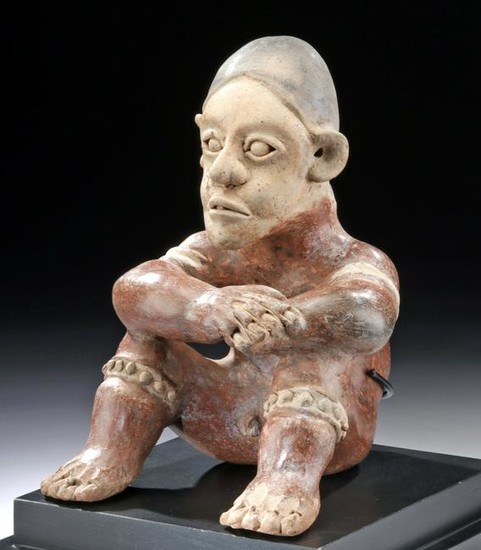Jalisco Ameca Etzatlan Polychrome Seated Male Hunchback
Pre-Columbian, West Mexico, Jalisco, Ameca-Etzatlan style, Protoclassic period, ca. 100 BCE to 250 CE. A wonderful example of a hand-built and highly burnished pottery figure displaying expert stylization and intricate detailing. The nude male sits with a forward-leaning posture due to his dramatically hunched back and has bent arms and legs with deep nail beds on the fingers and toes. Tight circular bands adorn each arm and leg, and the body is colored with red-brown slip. The raised head bears an attentive countenance with puffy ovoid eyes, an aquiline nose with mounded nostrils, full lips beneath shallow nasolabial folds, and cupped ears, all beneath a smooth forehead and a simple cap. Size: 6.375" W x 9.2" H (16.2 cm x 23.4 cm); 11.3" H (28.7 cm) on included custom stand.
West Mexican shaft tomb figures like this example derive their names from the central architectural feature that we know of from this culture. Jalisco, located on Mexico's southwestern coast, was part of the shaft tomb culture during this time, along with neighbors in nearby Colima and Nayarit. These people would build generally rectangular vertical or near-vertical shafts down from the ground level - usually about 3 to 20 meters deep - through tepetate, the volcanic tuff that makes up the geology of the region, to narrow horizontal tunnels that led to one or more vaulted or rounded burial chambers.
These shafts were almost always dug beneath a dwelling, probably a family home, and seem to have been used as family mausoleums, housing the remains of many related individuals. Figures like this one were placed into the tombs; researchers believe that they were placed around the edges facing inward, as if in conversation with the dead. Grouped with other figures, and alongside clay bowls, and boxes, figures like this one were positioned around the body (or bodies), near the skull.
Provenance: private S.H. collection, Santa Clara, California, USA, acquired around 2000; ex-Robert Dowling Tribal Arts collection, San Francisco, California, USA; ex-Larry Stone collection, Oakland, California, USA
All items legal to buy/sell under U.S. Statute covering cultural patrimony Code 2600, CHAPTER 14, and are guaranteed to be as described or your money back.
A Certificate of Authenticity will accompany all winning bids.
We ship worldwide to most countries and handle all shipping in-house for your convenience.
#152188
Condition Report: Minor abrasions and nicks to limbs, body, hunched back, and head, with fading to areas of original pigmentation, and minor softening to some finer details, otherwise intact and excellent. Light earthen deposits, nice root marks and manganese blooms, and great traces of original pigment throughout. Nice craquelure to original pigment.
View it on
Sale price
Estimate
Time, Location
Auction House
Pre-Columbian, West Mexico, Jalisco, Ameca-Etzatlan style, Protoclassic period, ca. 100 BCE to 250 CE. A wonderful example of a hand-built and highly burnished pottery figure displaying expert stylization and intricate detailing. The nude male sits with a forward-leaning posture due to his dramatically hunched back and has bent arms and legs with deep nail beds on the fingers and toes. Tight circular bands adorn each arm and leg, and the body is colored with red-brown slip. The raised head bears an attentive countenance with puffy ovoid eyes, an aquiline nose with mounded nostrils, full lips beneath shallow nasolabial folds, and cupped ears, all beneath a smooth forehead and a simple cap. Size: 6.375" W x 9.2" H (16.2 cm x 23.4 cm); 11.3" H (28.7 cm) on included custom stand.
West Mexican shaft tomb figures like this example derive their names from the central architectural feature that we know of from this culture. Jalisco, located on Mexico's southwestern coast, was part of the shaft tomb culture during this time, along with neighbors in nearby Colima and Nayarit. These people would build generally rectangular vertical or near-vertical shafts down from the ground level - usually about 3 to 20 meters deep - through tepetate, the volcanic tuff that makes up the geology of the region, to narrow horizontal tunnels that led to one or more vaulted or rounded burial chambers.
These shafts were almost always dug beneath a dwelling, probably a family home, and seem to have been used as family mausoleums, housing the remains of many related individuals. Figures like this one were placed into the tombs; researchers believe that they were placed around the edges facing inward, as if in conversation with the dead. Grouped with other figures, and alongside clay bowls, and boxes, figures like this one were positioned around the body (or bodies), near the skull.
Provenance: private S.H. collection, Santa Clara, California, USA, acquired around 2000; ex-Robert Dowling Tribal Arts collection, San Francisco, California, USA; ex-Larry Stone collection, Oakland, California, USA
All items legal to buy/sell under U.S. Statute covering cultural patrimony Code 2600, CHAPTER 14, and are guaranteed to be as described or your money back.
A Certificate of Authenticity will accompany all winning bids.
We ship worldwide to most countries and handle all shipping in-house for your convenience.
#152188
Condition Report: Minor abrasions and nicks to limbs, body, hunched back, and head, with fading to areas of original pigmentation, and minor softening to some finer details, otherwise intact and excellent. Light earthen deposits, nice root marks and manganese blooms, and great traces of original pigment throughout. Nice craquelure to original pigment.



